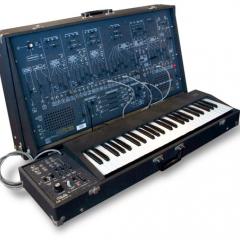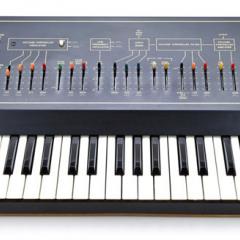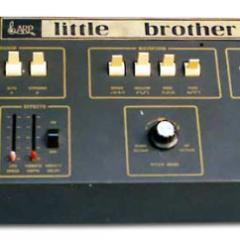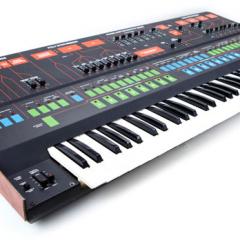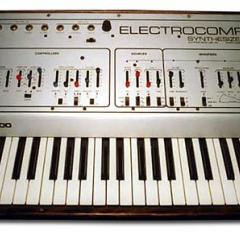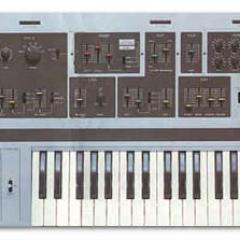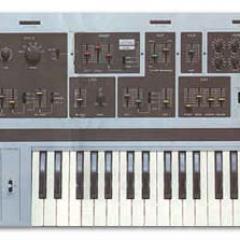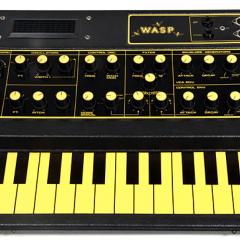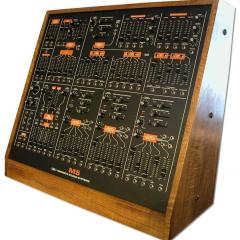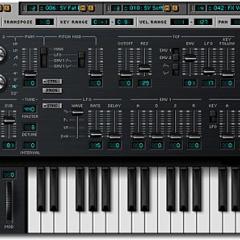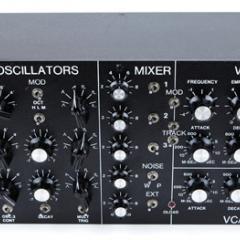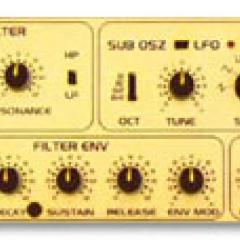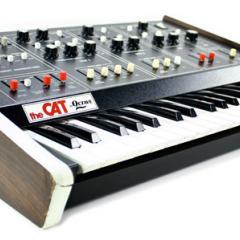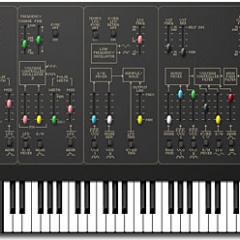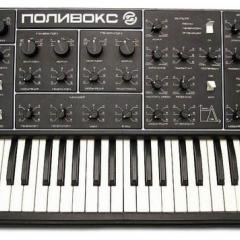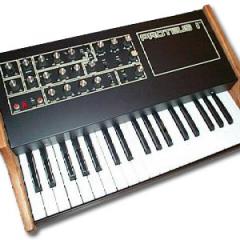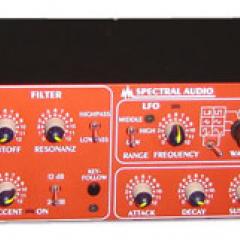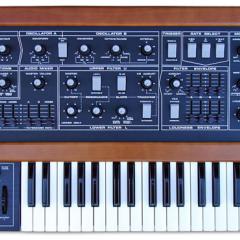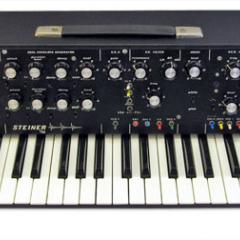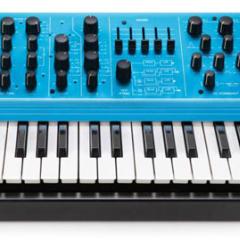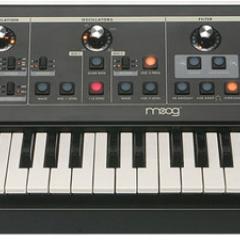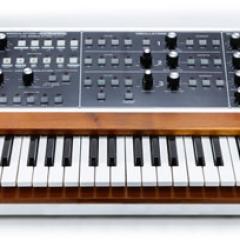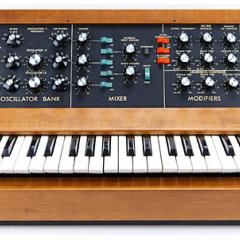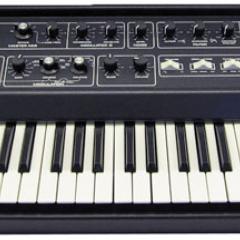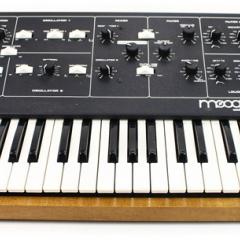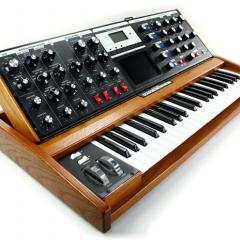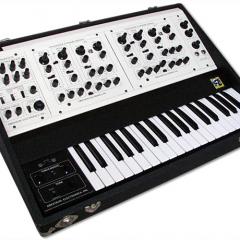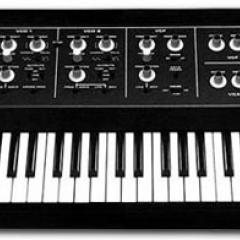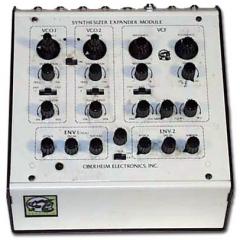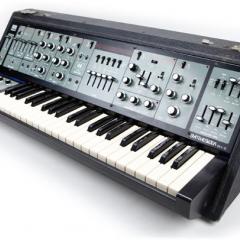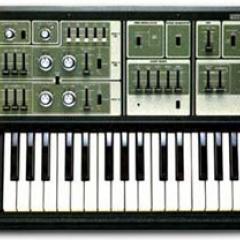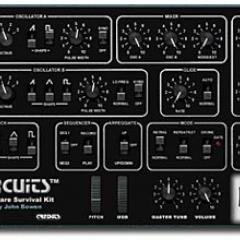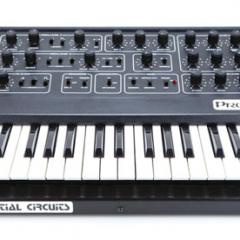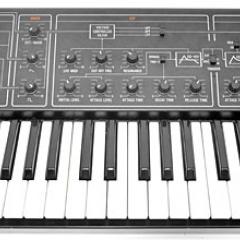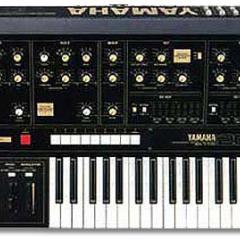ARP Odyssey 1
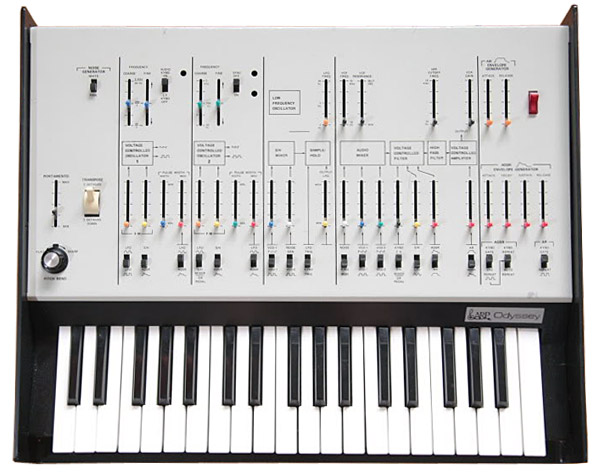
Odyssey Mk I (Model 2800)
While the Minimoog proved to be a runaway success as the first compact studio synthesizer, ARP responded with a compact and user-friendly studio synthesizer of their own with the Odyssey in 1972. An almost equally legendary machine itself, the Odyssey was ARP's highest selling synth back then, and still is to this day in the second-hand market.
The Odyssey essentially gives you a simplified hard-wired ARP 2600 in a much smaller and affordable package. The Odyssey is a 2-oscillator analog synth (with duo-phonic capability) and it sounds really nice; the Minimoog has three oscillators and is capable of thicker sounds. The Odyssey comes well equipped with all the tweakable features and analog goodness you'd expect: a resonant low pass filter, ADSR envelopes, sine or square wave LFO, and a sample-and-hold function.
The Odyssey also added a few new features such as a high pass filter that could be used in series with the low pass, oscillator-sync capability, and pulse-width modulation. It is a very professional and expressive machine that can create nice analog basses, interesting leads, great effects and sweeping sounds straight out of a Tangerine Dream album!
There were many versions of the Odyssey over the years, each a little different. They can be broken down into 8 models spanning 3 Mark "Mk" versions:
Odyssey Mk I (Model 2800)
First came the Odyssey Mk I (Model 2800) produced between 1972-75. These used a smooth but tinny sounding 2-pole voltage-controlled filter design (model 4023) similar to those used in the Oberheim SEM modules. From 1972 to 74 the Odyssey was produced with a white-faced front panel with black lettering. During 1974 to 75 they switched to a redesigned black front panel with gold lettering. However, all Mk I's can be identified by the rotary knob they use for pitch bending. None had any interface jacks, but a factory modification was available to add interface jacks as well as a PPC pitch bender in place of the rotary knob.
![]() Odyssey I Model 2800 photos: Front,
Left, Right,
Rear, Rear
2, Panel 1, Panel
2
Odyssey I Model 2800 photos: Front,
Left, Right,
Rear, Rear
2, Panel 1, Panel
2
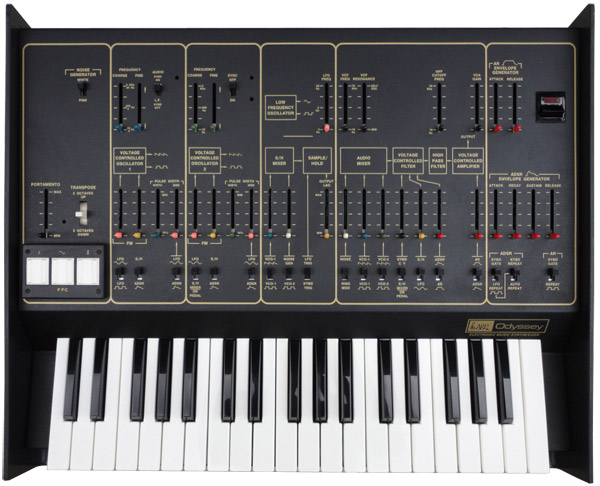
Odyssey Mk II (Model 2813)
Image from ANALOG, U.S., INC.'s Ebay store.
Odyssey Mk II (Models 2810-2815)
Then the Odyssey Mk II series came along, featuring 5 models (2810-2815) which were produced between 1975 to 78. Visually, they continued with the black and gold color-scheme seen on the late Mk I's. But under the hood, the Mk II series had several improvements. The VCO design was improved for better tracking. The power supply was improved. The sample+hold memory was improved. The keyboard current source was improved allowing for CV and Gate control to be added. The rotary pitch bend knob was also replaced by ARP's own PPC (Proportional Pitch Controller) - three pressure sensitive buttons, either by factory modification kit on earlier models, or from the factory on later models.
But the biggest change in the Mk II was in its filter. Early versions of the 2810 model still had the 2-pole model 4023 filter used in the Mk I but were soon replaced with a beefier 4-pole VCF (model 4035). This filter used a ladder design that was very similar to the Moog filter. While rumors persist that Moog sued ARP over this, no suit ever occurred. Arp and Moog came to an amicable agreement and a small licensing fee was paid by ARP for units previously manufactured. ARP soon after designed a new 4-pole, low pass filter - the model 4075 filter - which was used in all subsequent Odyssey models. Unfortunately, while the new model 4075 version of the filter was still beefy at low frequencies and very stable, it also had a well known bandwidth limit error around 12 to 14 kHz, resulting in a weak sound at high resonance or when driven into self-oscillation. This has made the rarer black and gold 2810 Odysseys with the model 4035 Moog-like ladder filter the more sought after and pricier models.
![]() Odyssey II Model 2810 photos: Close-up,
Rear
Odyssey II Model 2810 photos: Close-up,
Rear![]() Odyssey II Model 2813 photos: Front,
Left,
Right,
Rear
Odyssey II Model 2813 photos: Front,
Left,
Right,
Rear
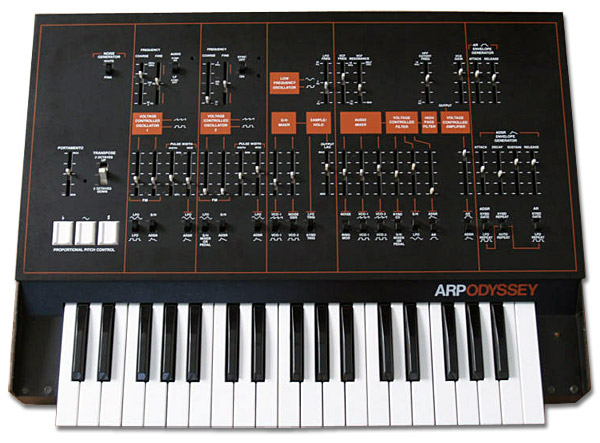
Odyssey Mk III (Model 2823)
Odyssey Mk III (Models 2820-2823)
Another cosmetic make-over saw the release of the Mk III series (Models 2820-2823) produced from 1978-81. These models are virtually the same as the Mk II except that the overall look and quality were set to match the look of the latest ARP synths with the orange and black color-scheme, and a more rugged steel chassis. In addition to its 1/4" outputs, XLR outputs were also added. The Odyssey Mk III is the most commonly found model.
![]() Odyssey III Model 2823 photos: Front,
Panel 1,
Panel 2,
Rear
Odyssey III Model 2823 photos: Front,
Panel 1,
Panel 2,
Rear
Over its 30-plus year history, Odysseys have been used by ABBA, Bomb The Bass, Ultravox, Gary Numan, LTJ Bukem, Air, Tangerine Dream, 808 State, Apollo 440, Nine Inch Nails, Astral Projection, Chick Corea, George Duke, Josef Zawinul, John Foxx, Vangelis, Elton John, Jethro Tull, Jimmy Edgar, DEVO, Sea Level, Boz Scaggz, The Starship, Kansas, Jean-Luc Ponty, Brand-X, Wigwam, R.E.M. and Herbie Hancock.
Charting the History of Odyssey Models
| Model | Series | Year | Color | Filter | Boards | Pitch Bend | Interface | Chassis |
|---|---|---|---|---|---|---|---|---|
| Mark I series | ||||||||
| 2800 | mk I | 72 - 74 | White+Black | 4023 | A-I, B-I, C-I | Rotary knob | No interface jacks | Wrap around vinyl bottom |
| 2800 | mk I | 74 - 75 | Black+Gold | 4023 | A-I, B-I, C-I | Rotary knob | No interface jacks | Wrap around vinyl bottom |
| Mark II series | ||||||||
| 2810 | mk II | 75 - 76 | Black+Gold | 4035 | A-II, B-I or B-II, C-II | Rotary knob | No interface jacks | Wrap around vinyl bottom |
| 2810 | mk II | 76 - 78 | Black+Gold | 4075 | A-II, B-II, C-II | Rotary Knob or PPC | CV/Gate+Trig | Wrap around vinyl bottom |
| 2811 | mk II | 76 - 78 | Black+Gold | 4075 | A-II, B-II, C-II | Rotary Knob or PPC | CV/Gate+Trig | Wrap around vinyl bottom |
| 2812 | mk II | 76 - 78 | Black+Gold | 4075 | A-II, B-II, C-II | Rotary Knob or PPC | CV/Gate+Trig | Wrap around vinyl bottom |
| 2813 | mk II | 76 - 78 | Black+Gold | 4075 | A-II, B-II, C-II | Rotary Knob or PPC | CV/Gate+Trig | Wrap around vinyl bottom |
| 2815 | mk II | 76 - 78 | Black+Gold | 4075 | A-II, B-II, C-II | Rotary Knob or PPC | CV/Gate+Trig | Wrap around vinyl bottom |
| Mark III series | ||||||||
| 2820 | mk III | 78 - 81 | Black+Orange | 4075 | A-II, B-II, C-II | PPC | CV/Gate+Trig | Steel chassis, leather endblocks |
| 2823 | mk III | 78 - 81 | Black+Orange | 4075 | A-II, B-II, C-II | PPC | CV/Gate+Trig | Steel chassis, leather endblocks |
Demos & Media
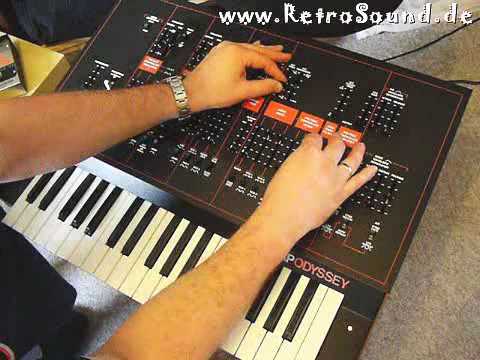

Specifications
Model 4035 & 4075 (later models): Four-pole resonant 24dB lowpass filter, high pass filter (static); can be modulated by: keybd track, sample-and-hold, sine LFO, ADSR, AR; ring modulator
Websites of Interest
Resources
Images from Ebay auctions and Tone Tweakers
Review updated September 2011
